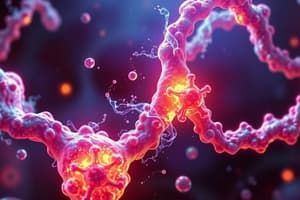Podcast
Questions and Answers
What is the primary role of enzymes in biological reactions?
What is the primary role of enzymes in biological reactions?
Which of the following statements describes the specificity of enzymes?
Which of the following statements describes the specificity of enzymes?
What are cofactors and coenzymes in relation to enzymes?
What are cofactors and coenzymes in relation to enzymes?
What is the composition of a holoenzyme?
What is the composition of a holoenzyme?
Signup and view all the answers
In the lock-and-key model, what does the 'key' represent?
In the lock-and-key model, what does the 'key' represent?
Signup and view all the answers
Which of the following can be considered a prosthetic group?
Which of the following can be considered a prosthetic group?
Signup and view all the answers
What type of reaction is catalyzed by an oxidoreductase enzyme?
What type of reaction is catalyzed by an oxidoreductase enzyme?
Signup and view all the answers
What determines the activity of enzymes with respect to temperature and pH?
What determines the activity of enzymes with respect to temperature and pH?
Signup and view all the answers
What does the Michaelis constant (Km) indicate about an enzyme's affinity for its substrate?
What does the Michaelis constant (Km) indicate about an enzyme's affinity for its substrate?
Signup and view all the answers
Which type of inhibitor binds to the enzyme-substrate complex only?
Which type of inhibitor binds to the enzyme-substrate complex only?
Signup and view all the answers
At what point is the maximal rate of reaction (V max) achieved?
At what point is the maximal rate of reaction (V max) achieved?
Signup and view all the answers
Which of the following best describes reversible enzyme inhibition?
Which of the following best describes reversible enzyme inhibition?
Signup and view all the answers
Which property distinguishes allosteric enzymes from those that follow Michaelis-Menten kinetics?
Which property distinguishes allosteric enzymes from those that follow Michaelis-Menten kinetics?
Signup and view all the answers
Which statement about non-reversible inhibition is true?
Which statement about non-reversible inhibition is true?
Signup and view all the answers
Which scenario effectively describes competitive inhibition?
Which scenario effectively describes competitive inhibition?
Signup and view all the answers
What characterizes the reaction kinetics of allosteric enzymes?
What characterizes the reaction kinetics of allosteric enzymes?
Signup and view all the answers
What does a positive ΔG indicate about a reaction?
What does a positive ΔG indicate about a reaction?
Signup and view all the answers
Which statement is true regarding ΔG and reaction rates?
Which statement is true regarding ΔG and reaction rates?
Signup and view all the answers
What is the Gibbs free energy of activation?
What is the Gibbs free energy of activation?
Signup and view all the answers
What effect do enzymes have on a chemical reaction?
What effect do enzymes have on a chemical reaction?
Signup and view all the answers
At what point is the initial velocity (V0) of a reaction determined?
At what point is the initial velocity (V0) of a reaction determined?
Signup and view all the answers
Which statement about exergonic reactions is true?
Which statement about exergonic reactions is true?
Signup and view all the answers
What is the primary focus of enzyme kinetics?
What is the primary focus of enzyme kinetics?
Signup and view all the answers
What is the role of binding energy in catalysis?
What is the role of binding energy in catalysis?
Signup and view all the answers
What does the induced-fit model describe in enzyme-substrate interaction?
What does the induced-fit model describe in enzyme-substrate interaction?
Signup and view all the answers
Which type of bond is NOT typically involved in the enzyme-substrate (ES) complex?
Which type of bond is NOT typically involved in the enzyme-substrate (ES) complex?
Signup and view all the answers
What is the implication if the Gibbs free energy (∆G) of a reaction is negative?
What is the implication if the Gibbs free energy (∆G) of a reaction is negative?
Signup and view all the answers
What effect do enzymes have on the energy required to initiate a reaction?
What effect do enzymes have on the energy required to initiate a reaction?
Signup and view all the answers
How do enzymes utilize energy derived from ATP?
How do enzymes utilize energy derived from ATP?
Signup and view all the answers
What determines whether a reaction will take place spontaneously?
What determines whether a reaction will take place spontaneously?
Signup and view all the answers
What reflects the specificity of an enzyme towards its substrate?
What reflects the specificity of an enzyme towards its substrate?
Signup and view all the answers
What is the relationship between reaction rate and enzymes?
What is the relationship between reaction rate and enzymes?
Signup and view all the answers
Study Notes
Enzymes Overview
- Enzymes are biological catalysts that accelerate chemical reactions by providing an alternative reaction pathway with lower activation energy.
- Carbonic anhydrase is one of the fastest enzymes, catalyzing the hydration of 10^6 molecules of CO2 per second, making the reaction 10^7 times faster than without a catalyst.
Molecular Nature of Enzymes
- Enzymes can be composed solely of proteins (simple enzymes) or include additional non-protein components (conjugated enzymes) - the latter consists of an apoenzyme (protein part) and cofactors.
- Cofactors are essential for enzymes to perform reactions and can be inorganic (metal ions like Fe, Mg, Zn) or organic (coenzymes such as vitamins, NAD, NADP).
Enzyme Specificity
- Enzymes exhibit specificity for particular substrates or reactions due to their unique three-dimensional structure.
- The active site of an enzyme is a specific region that binds substrates through weak forces, leading to reactions.
Enzyme Models
- Lock-and-Key Model: The active site is complementary in shape to the substrate.
- Induced-Fit Model: The enzyme changes shape upon substrate binding, creating a complementary fit.
Thermodynamics and Enzyme Activity
- Gibbs free energy (∆G) determines the spontaneity of reactions:
- Negative ∆G (exergonic) indicates a spontaneous reaction.
- Zero ∆G indicates equilibrium, and positive ∆G (endergonic) indicates non-spontaneity.
- Enzymes speed up reactions but do not affect the overall equilibrium or amount of product formed.
Reaction Rate and Kinetics
- The initial velocity (V₀) of an enzyme-catalyzed reaction can be determined by plotting product formation versus time.
- V₀ increases with substrate concentration until the enzyme is saturated, reaching maximal rate (Vmax).
- Michaelis constant (Km) reflects substrate concentration at which the reaction velocity is half Vmax, indicating enzyme-substrate affinity; lower Km signifies higher affinity.
Enzyme Inhibition
- Enzyme inhibition can be reversible or irreversible:
- Reversible inhibition allows for rapid regulation of enzyme activity.
- Non-reversible inhibition results from degradation or covalent modification, often involving toxins.
- Three types of reversible inhibition:
- Competitive Inhibition: Inhibitor competes with substrate for the active site.
- Uncompetitive Inhibition: Inhibitor binds only to the enzyme-substrate complex.
- Noncompetitive Inhibition: Inhibitor binds to an enzyme regardless of whether the substrate is bound.
Allosteric Enzymes
- Allosteric enzymes display conformational changes in response to regulatory molecules, impacting their activity (activation or repression).
- They typically show sigmoidal kinetics rather than typical Michaelis–Menten kinetics, and they consist of multiple subunits and active sites.
- Feedback regulation is a common form of control in allosteric enzymes, ensuring metabolic balance.
Studying That Suits You
Use AI to generate personalized quizzes and flashcards to suit your learning preferences.
Description
This quiz covers the fundamental concepts of enzymes, including their role as biological catalysts and their composition. You will explore enzyme specificity, the importance of active sites, and the involvement of cofactors in enzymatic reactions.





